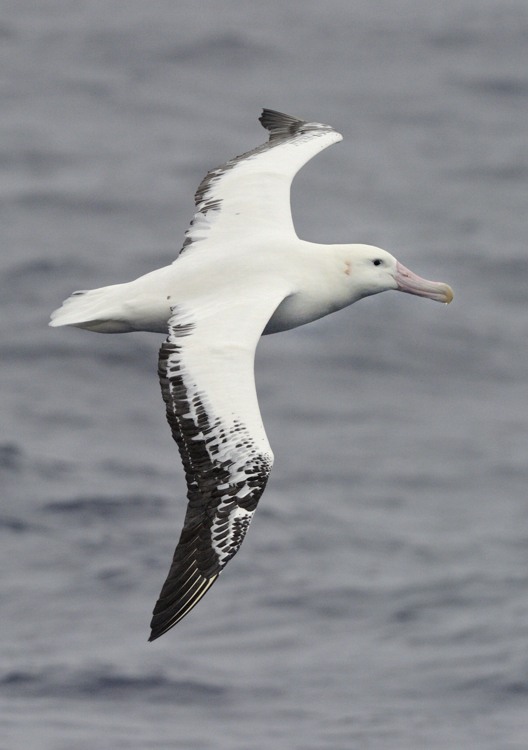
A 29-year-old male Wandering Albatross guards its chick near Prinsloomeer on South Africa's Marion Island on 17 April 2005; the bird was banded as a chick on 2 November 1976, photograph by John Cooper
The “great albatrosses” in the genus Diomedea can be divided into two groups, the two royal albatrosses, endemic to New Zealand and what can be called the “wandering-type group or complex” which is generally considered to be made up of four closely related (and hard to identify at sea) species. These are the Amsterdam D. amsterdamensis, Antipodean D. antipodensis (with two subspecies, antipodensis and gibsoni), the Tristan D. dabbenena and the Wandering D. exulans. A view exists that the two Antipodean subspecies should be afforded specific status. D. a. gibsoni would then become known as Gibson’s Albatross. Both these subspecies have also been described as “Antipodean Wandering” and Gibson’s Wandering” in the literature, with the Antipodean sensu lato being called the New Zealand Albatross.
The Wandering Albatross currently has no recognized subspecies. Historically, D. e. chionoptera has been described as a subspecies of the Wandering Albatross (originally as a full species by Salvin in 1986), but is no longer recognized, making the species monotypic. The taxon, used to describe the larger and generally whiter Wandering Albatrosses of the sub-Antarctic, became known as the Snowy Albatross.
Nowadays, “Snowy” seems to be mainly used on social media groups, often by seabird watchers who frequent “pelagic trips” in the southern hemisphere. It is not used as a primary common name by most handbooks, scientific journals, the Agreement on the Conservation of Albatrosses and Petrels (ACAP), BirdLife International, IUCN and New Zealand Birds Online (although it is mentioned by some of them as an alternative common name). However, it is used in some (but not all) recent field guides, by Wikipedia, eBird, in Cornell Lab’s online Birds of the World series and by the IOC World Bird List, thus perpetuating its use among birdwatchers.

A Wandering Albatross in the Drake Passage, photograph by Kirk Zufelt
To avoid too much confusion, I suggest that those who prefer to call the Wanderer a Snowy when writing in social media outlets and for non-scientific print publications, explain at first usage that they are referring to the Wandering Albatross Diomedea exulans. For scientific publications, handbooks and the like I suggest authors stick to using “Wandering” and avoid the term “Snowy”.
Selected Publications:
Bourne, W.R.P. 1989. The evolution, classification and nomenclature of the great albatrosses. Le Gerfaut 79: 105-116.
Burg, T.M. & Croxall, J.P. 2004. Global population structure and taxonomy of the Wandering Albatross species complex. Molecular Ecology 13: 2345-2355.
Medway, D. 1993. The identity of the Chocolate Albatross Diomedea spadicea Gmelin, 1789 and of the Wandering Albatross Diomedea exulans of Linnaeus, 1758. Notornis 40: 145-162.
Schodde, R., Tennyson, A.J.D., Groth, J.G., Lai, J.; Scofield, P. & Steinheimer, F.D. 2017. Settling the name Diomedea exulans Linnaeus, 1758 for the Wandering Albatross by neotypification. Zootaxa 4236 (1): 135.
John Cooper, Emeritus Information Officer, Agreement on the Conservation of Albatrosses and Petrels, 02 July 2024, updated 03 July 2024

 Français
Français  English
English  Español
Español